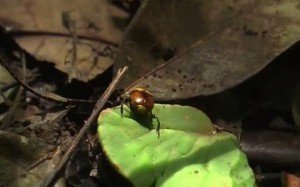
(Voice of America) Every year, about 1,000 scientists from around the world visit the Smithsonian Tropical Research Institute in Panama. The Institute is one of the oldest and largest facilities of its kind in the world. Its research on flora, fauna and geology is responsible for many recent discoveries about how the Earth’s tropical ecosystems work.
Barro Colorado Island
It’s 6 o’clock in the morning, and light barely filters through the canopy of this tropical rainforest on Barro Colorado Island in Panama. But neither insects, the lack of light nor the intense humidity deter these scientists. They are looking for monkeys.
Anthropology Professor Stephanie Ramirez studies spider monkeys. “I am interested in knowing how food affects their reproductive potential, because spider monkeys mostly consume fruit, and we noticed that when fruit is not abundant or available they can’t conceive,” she said.
There are 1,800 monkeys on the island; 39 of them are spider monkeys. Eight of have had radio collars placed around their necks.
Ramirez and her assistant Lauren Mills can locate the animals by picking up their signals with a radio receiver.
Field studies
The two researchers are only a small contingent. About 1,000 scientists come here every year for field studies.
“The Smithsonian Tropical Research Institute here in Panama is something of a mecca for all biologists in the world who are interested in the tropics and in tropical biology,” explains Tony Coates, a scientist emeritus with the Institute.
The Institute was established in Panama 100 years ago. Today, Barro Colorado is the most studied rain forest in the world.
Abby Bruning came from South Dakota to study ants. “We manipulate their diets. Either they will be on a high carbohydrate or a high protein diet and at the end we run analyses to see how well they fight off infection, death rates and things like that,” Bruning stated. She studies one of about 200 species of ants here.
Pink flower trees on the forest’s canopy are Dipteryx Panamensis, better known as Almendro. The working ants love the flowers and take them home, one petal at a time. It took Azteca ant colony more than a year to build their structure. They are the favorite meal of ant eaters.
Smithsonian scientists estimate there are about 100 species of mammals on this tiny island. More than half of them are bats. There are 71 species of reptiles and about 30 million insect species.
“The vast majority of all species of plants and animals live in the tropics. The vast majority of all the technical knowhow, political will, education and financing are in the temperate world. How to get those two worlds together is one of the greatest issues facing global conservation,” Coates explained.
Tropical biology library
The Smithsonian Tropical Research Institute is headquartered in Panama City. Its library, with 70,000 volumes on tropical biology, is regarded by scientists as one of the best in the world.
“It follows the same system as the Library of Congress,” Coates added.
Nearby, Culebra, a major Smithsonian educational center, is open to the public. One hundred thousand people, mostly Panamanian school children, visit this center each year.
“That’s our biggest educational contribution to our host country of Panama,” Coates noted.
As the Smithsonian Tropical Research Institute in Panama prepares for its centennial, it is also getting ready to launch new research facilities in the town of Gamboa.
Private donors want STRI to examine subjects of growing concern today, such as the forest’s ability to control erosion and to capture carbon from the air, and ways to restore and preserve one of the richest and most important excosystems on the planet.